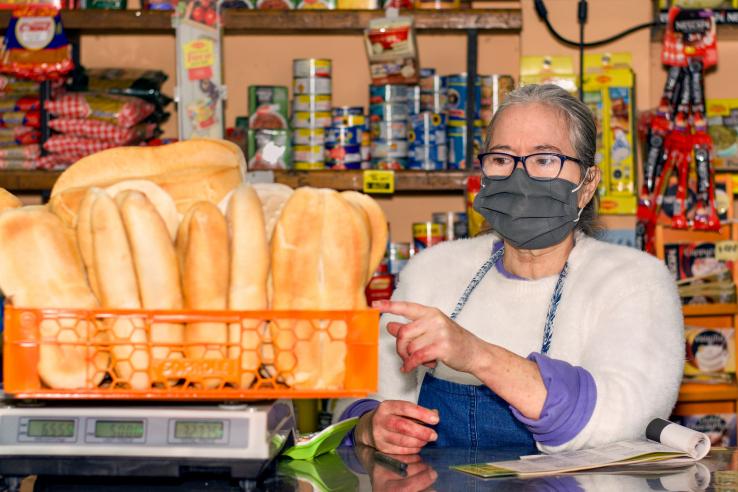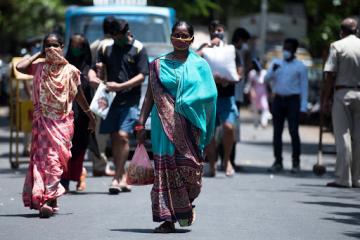
Mapping the impact of COVID-19 on firms in LMICs: A snapshot from ongoing surveys

The recent success of two COVID-19 vaccines in clinical trials has many around the world hopeful that a return to normal is within sight. But for many low- and middle-income countries (LMICs), widespread access to the vaccine is on a much lengthier timeline, likely deepening the long-term impact of the pandemic on national economies.
To understand how the pandemic has altered the business landscape in LMICs, J-PAL’s Firms Sector is synthesizing results from surveys conducted by J-PAL affiliates and invited researchers on the impact of COVID-19 on micro, small, and medium enterprises (MSMEs) around the world. This snapshot complements the great ongoing work by our partners at Innovations for Poverty Action and the International Growth Centre to document the economic impact of COVID-19 on MSMEs.
The surveys
Survey evidence is increasingly becoming available, but relatively few results have been made public as of November 2020. As such, the following write-up is based on results from twelve surveys from the J-PAL network across eleven countries in Latin America and Africa.
Nine of these surveys were conducted in nine Latin American countries as part of a broader international COVID-19 small business study. Two of the featured surveys were funded by J-PAL’s Jobs and Opportunity Initiative (JOI). In some cases, researchers leveraged existing infrastructure from previous or ongoing randomized evaluations, allowing them to quickly launch data collection for these surveys.
While many of these surveys are ongoing, the ones we highlight here feature data collected between March and June 2020. As such, the takeaways from this review speak to the immediate response period of the pandemic and may not reflect the current state of MSMEs.
Key takeaways on the state of MSMEs in the early months of the COVID-19 crisis
A large percentage of businesses experienced temporary and permanent closures due to COVID-19.
Two surveys in Nigeria found that 43 percent of informal market vendors and 85 percent of wholesale and retail traders experienced temporary or permanent shop closures. Most temporary closures were a result of a five-week lockdown instituted by the Lagos State Government between the end of March and beginning of May.
Among the informal market vendors surveyed, 10 percent had closed their businesses permanently due to COVID-19 related challenges as of May. Less than 2 percent of informal vendors reported zero impact of COVID-19 on their business operations. Among wholesale and retail traders, 85 percent considered their businesses to be in operation at the time of the survey, and the remainder expected to reopen in the near future. The majority of businesses that experienced a temporary closure reopened following loosening of restrictions.
Weekly profits/revenue declined among businesses impacted by closures.
In Nigeria, 91 percent of wholesale and retail traders reported zero income while temporarily closed, although one month after lockdowns were lifted, sales improved to approximately three-quarters of February (pre-pandemic) levels. In Sierra Leone, weekly profits of businesses owners remained around 50 percent lower after the nationwide lockdown than they were before the pandemic, and did not increase over time.
Many businesses were forced to lay off workers and reduce working hours.
Firms across Latin America reported having to lay off workers during lockdowns, and many expected to have to lay off more workers in the next three months. The percentage of firms in survey samples reporting layoffs due to COVID-19 ranges from as low as 30 percent (Argentina) to as high as 73 percent (Colombia). In general, an equal or higher percentage of firms who reported layoffs in each country expected to have to lay off workers in the near future.
Surveys in Nigeria and Sierra Leone found that respondents’ working hours declined after the onset of the pandemic.
Firms sizes in Latin America changed between January and April 2020, with the number of firms with over 3 employees shrinking. In general, however, the number of firms with 0-2 employees grew to have more employees than before the pandemic. A possible explanation for this could be an increase in subsistence microentrepreneurship following layoffs, or other reasons.
Businesses faced both supply and demand side challenges as a result of the pandemic.
Surveys in Nigeria and Sierra Leone find that business owners experienced lower demand for their products and difficulty accessing suppliers.
In terms of domestic sourcing, wholesale and retail traders in Nigeria saw the number and total value of purchases fall by well over half compared to a similar period in 2020. Importing took a very large hit—for instance, over half of interviewed traders in Nigeria sourced from China in 2019, while only about 12 percent did so in 2020.
Awareness of government support programs was very low in the first two to three months following the onset of the COVID-19 pandemic.
Across nine surveys in Latin America, the vast majority of surveyed business owners (47 percent to 92 percent) were not aware of any government programs that could assist them. In most cases, small and medium-sized business owners were less aware of relief programs compared to large business owners.
Knowledge of government support programs was also limited among survey respondents in Nigeria: only 29 percent knew about the steps the government is taking to help people. About 16 percent of surveyed business owners said they applied to government benefits to support their business, and only 2.5 percent reported that their business received benefits.
Across nine surveys in Latin America, firms varied in their optimism about recovering from the effects of the pandemic.
For example, 80 percent of firms in Ecuador expected to recover from the economic impacts of COVID-19 within the next two years, while 60 percent believed the same in Argentina.
Taken together, these results suggest that MSMEs took significant hits as a result of the pandemic, and for the most part, have not returned to pre-pandemic levels. Most firm owners were not aware of government assistance programs, suggesting that governments can do more to make these programs accessible. For example, we reviewed some ways the US Small Business Administration could increase program enrollment among small businesses earlier this year.
Next steps
Researchers are using these survey results to identify how government relief packages can help and determine the best ways to increase awareness and disseminate information regarding the relief that is available to small and medium sized businesses. In Latin America, researchers are working with Ministries of Economics and Finance across Brazil, Chile, the Dominican Republic, and Peru to use survey results to inform policy.
Several randomized evaluations are also testing approaches to support small and medium enterprises and mitigate the effect of the COVID crisis. For summaries of some of these ongoing projects, visit J-PAL’s Jobs and Opportunity Initiative funded projects page.
References
Neilson, Christopher, John Eric Humphries, Gabriel Ulyssea. 2020. “COVID-19 International Small Business Study.”
Gottlieb, Jessica A., Adrienne Lebas, Janica Magat. 2020. “Resilience and Risk in the Informal Sector: Responses to Economic and Security Risks of COVID-19 in Lagos, Nigeria: A Report from Survey Wave 1.”
Bishi, Hakeem, Shelby Grossman, Meredith Startz. 2020. “How COVID-19 has affected Lagos traders: Findings from high frequency phone surveys.”
Meriggi, Niccolo, Macartan Humphreys, Abou Bakarr Kamara, Matthew Krupoff, Madison Levine, Herbert Mcleod, Mushfiq Mobarak, Wilson Prichard, Ashwini Shridhar, Peter van der Windt, Maarten Voors. 2020. “Tracking the economic consequences of COVID-19.” IGC Working paper
Related Content

Too complicated, too confusing: why more small businesses aren’t applying for coronavirus relief loans, and what we can do to reach them

Taking an evidence-informed approach to pandemic response


